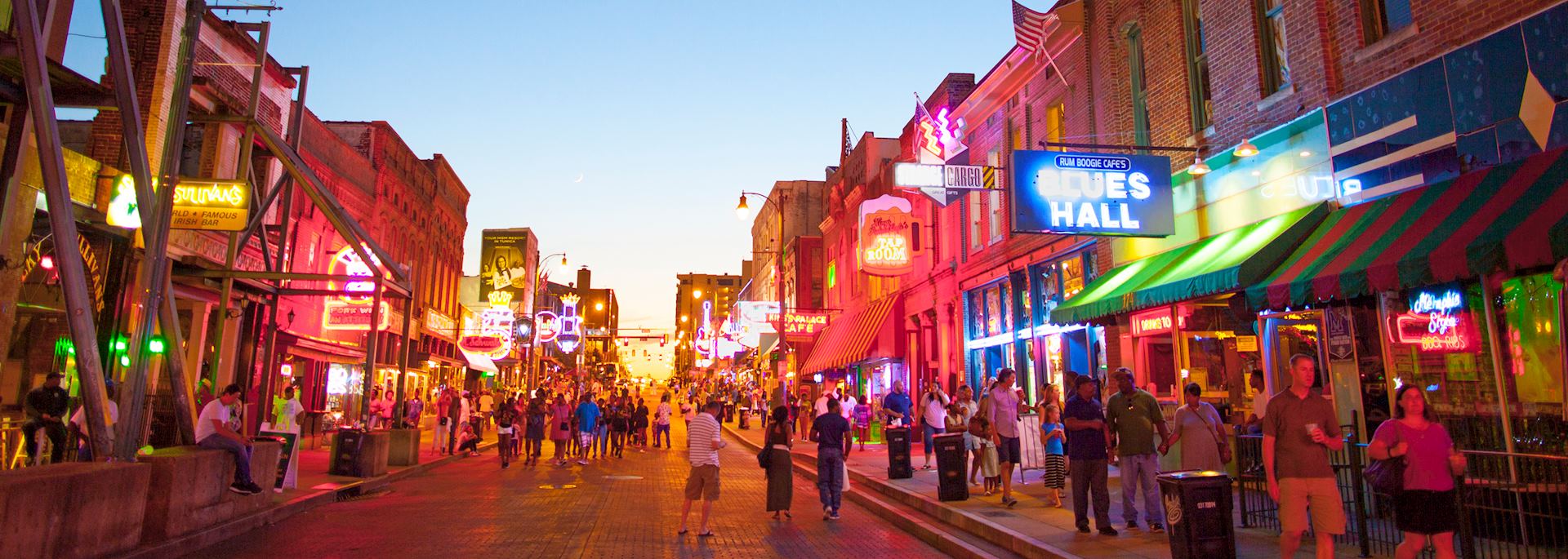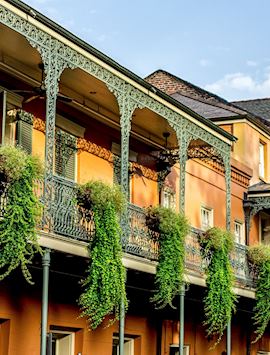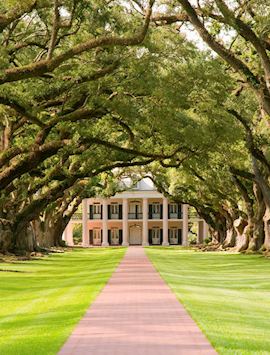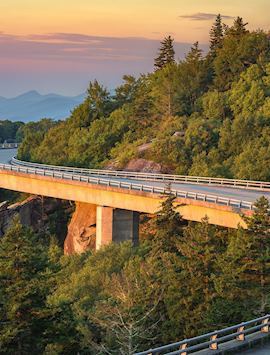By USA specialist Carl
Jazz, blues, country, soul, and rock ‘n’ roll — the music of the American South is used in celebration and in grief, for storytelling and worship, and to unite everyone from close families to complete strangers. What I love most about the region is that you can experience all of these genres and more in a single trip.
Throughout my own travels in the South, I’ve found that everyone’s eager to share their music, traditions, and way of life, and to involve you in their culture. As a result, I’ve gained a much deeper appreciation for the region’s musical heritage — not just in its most prominent cities, but in its smaller towns, too. So, here are the best destinations and experiences you can enjoy on your own music tour of the American South.
Music experiences in Nashville: Country music
Often referred to as ‘music city’, Nashville is synonymous with country music. Streets are lined with honky-tonk bars where artists thrash out country classics. Museums tell you about the city’s musical roots and the success stories of its biggest stars, from Johnny Cash to Willie Nelson. And, you can visit heritage bars, clubs, and performance halls that continue to launch rising local talent.
I recommend spending three nights here, which gives you time to see everything at a leisurely pace. Despite its size, Nashville is easy to navigate using the excellent free bus system that circulates the downtown.

Honky-tonk bars of Lower Broadway
With its dazzling neon lights and around-the-clock live music, Nashville’s Broadway Historic District has attracted people to its bars and restaurants for decades. While it’s unknown where the term ‘honky-tonk’ originated, it has become linked to the bars and clubs that line Lower Broadway — nicknamed ‘Honky Tonk Highway’.
There are typically no cover charges in these bars, so you’re free to come and go as you please. I find the best way to pick one is to stroll up and down the street until you hear a band you like (the bars all have big, open windows so you can listen in).
One of the most popular honky-tonks is Tootsie’s Orchid Lounge. The purple building catches your eye as you walk down the street, and it contains three floors of live music. I also like Nudie’s Honky Tonk, which is filled with memorabilia, including outfits worn by Johnny Cash and Hank Williams.
Some of country music’s biggest names began their careers in the honky-tonks here, including Gretchen Wilson, Kris Kristofferson, and Willie Nelson. Musicians often start their career with early daytime slots and work their way up to playing the bars at night, living out the Nashville dream. So, the artist you’re listening to as you sip whiskey and tap your feet to the beat might well become the next big thing.
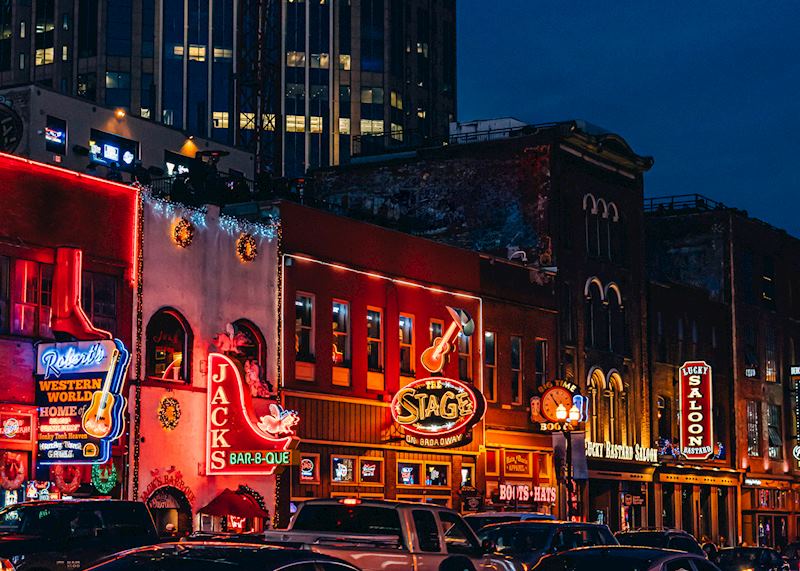
VIP backstage tour of the Grand Ole Opry
Speaking of Nashville music dreams, getting to play at the Grand Ole Opry is the pinnacle. A Nashville institution, the Opry is probably the region’s best-known music venue. The radio show of the same name has broadcast live country music since 1925, cementing the careers of country singers such as Patsy Cline, Carrie Underwood, and Hank Williams.
I can book you a ticket to one of the live broadcast shows, which take place on Tuesday, Friday, and Saturday nights. It’s not just for dedicated country fans, either. The atmosphere is a big part of the experience — everyone is so excited to be there, some having driven long distances just to attend. I remember people literally jumping for joy when artists walked to the stage. Amusingly, the announcer would also regularly pause proceedings to read out commercials — a reminder we were on air.
If you’re interested in what happens behind the scenes at a live music venue, I can arrange for you to take a VIP tour. You can do it before or after the show, but I always suggest a post-show tour so you don’t have to contend with the evening taxi rush.
After the radio show goes off air, you’ll head backstage in a small group with a guide who’ll talk about the show’s background. Signed posters of country stars adorn the walls, and you’ll get to peek inside some of the individually themed dressing rooms. But for me, the most exciting part was standing within the hallowed wooden circle that sits in the middle of the stage, the spot where artists sing — a physical marker for many that their dreams are finally coming true.
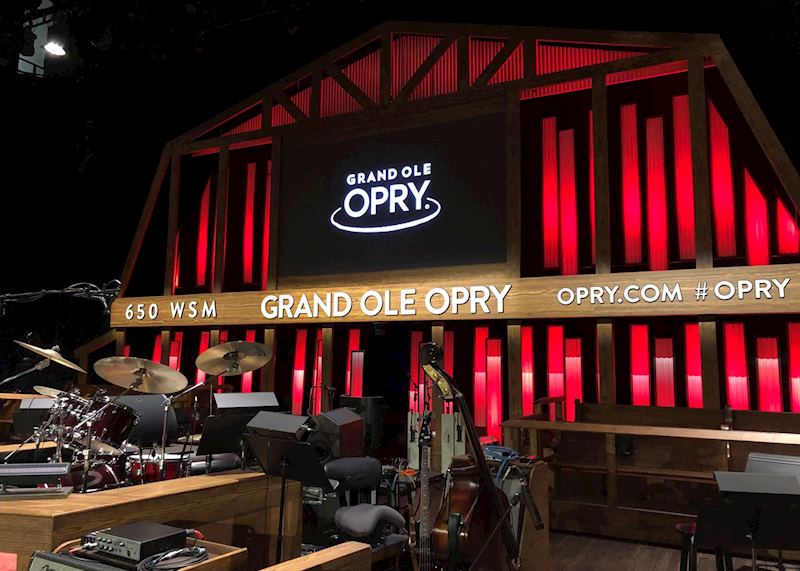
Music museums in Nashville
There are various museums dedicated to Nashville’s musical heritage. The largest is the Country Music Hall of Fame and Museum, where you could potentially spend hours exploring the history of the genre and the lives of the biggest country music stars. A visit here also includes entry to Historic RCA Studio B, where many of the artists recorded their songs.
If you’re a Johnny Cash devotee, there’s a museum dedicated to his life and work. Here you can see personal items and memorabilia, from instruments and letters to costumes and awards.
I also enjoyed visiting the Musicians Hall of Fame and Museum, which celebrates the US music industry as a whole. It’s very interactive: you can have a go at playing electric drums, keyboard, and guitar, or record yourself singing along to The Supremes. Though I’m not sure my contribution will earn me a spot in the charts any time soon…
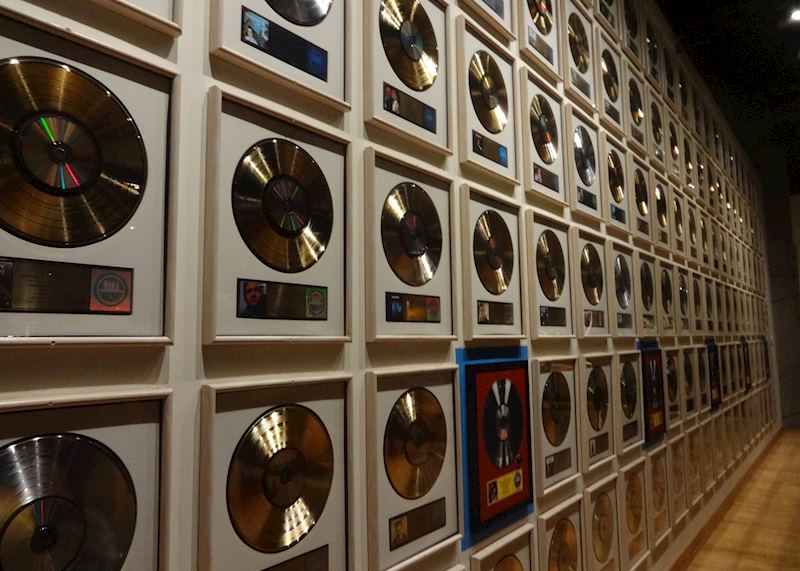
Music experiences in Memphis: Blues, soul, and rock ‘n’ roll
Memphis is home to Elvis’s sprawling Graceland complex, but the city’s musical legacy goes far beyond the King of Rock and Roll — blues and soul have a storied past here, too. The city isn’t quite as sleek as Nashville or as beautiful as New Orleans, but I like its laid-back feel, and the museums are some of the best in the region. A free shuttle bus also runs between Sun Studio, Beale Street, the Memphis Rock ‘n’ Soul Museum, and Graceland.
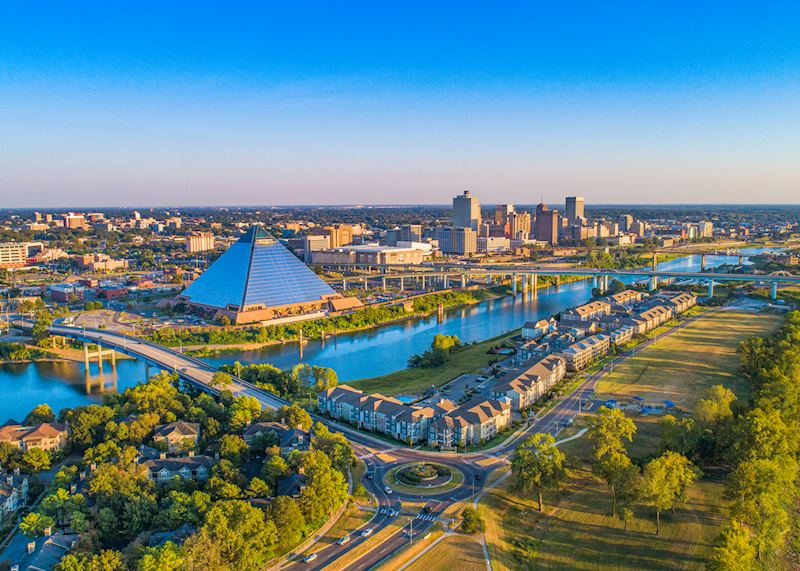
Graceland VIP tour
Preserved to look just as it did when Elvis lived here, Graceland’s interiors reflect the height of 1970s fashion, with shag-pile rugs, stained-glass doors, and bold reds, yellows, and blues contrasting against the stark white upholstery.
Different tours grant you varying levels of access, but I’ll book you a VIP pass so you can beat the long queues into the mansion. An audio tour tells you about the house and Elvis’s life as you wander through the rooms. Among them are his lounge and dining room, his billiard room, and an animal-ornamented, jungle-themed room.
After the mansion, you can look around the manicured grounds, where Elvis and some of his family are buried. Many fans make a pilgrimage to his tomb, particularly during Elvis Week, which takes place here every August.
You then enter the ‘Elvis Presley’s Memphis’ studio complex. The buildings hold some of Elvis’s finest possessions, including his vast automobile collection and his custom planes. Other exhibits trace almost every facet of his life, from his early years and his road to fame to the height of his celebrity and his key performances. You can see hundreds of personal items, including the many outfits he wore and letters he wrote during his brief spell in the military.
Though, if you’d like to get a better feel for where Elvis started out his life, I suggest taking a trip to nearby Tupelo. Here, you can see his two-room family home, built by his father, and the church he attended as a child. I found the contrast between this tiny house and the glitzy Graceland mansion quite startling. It felt like I was slotting in an important piece to the puzzle of his life.
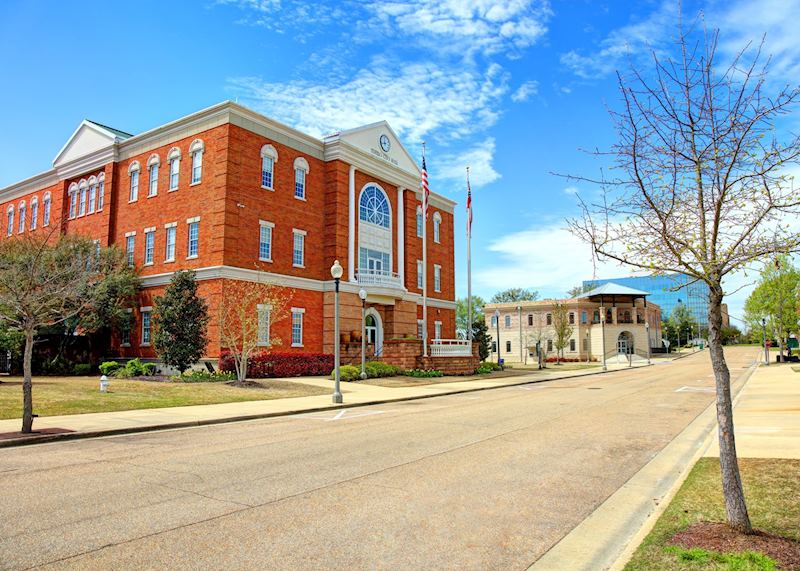
Beale Street’s blues clubs
Ever since the roaring 1920s, Beale Street has entertained the masses with its bars, clubs, and Memphis barbecue restaurants. The Memphis blues music genre first evolved here thanks to the likes of Louis Armstrong, B.B. King, and Muddy Waters, who performed in the street’s bars between the 1920s and 1940s.
Today, as you walk down the strip, the bright lights and neon signs haven’t faded. Live music fills its clubs and bars every evening, though some are purely party venues now. For an authentic taste of Memphis blues, head to the original B.B. King’s Blues Club, opened by the music legend himself.
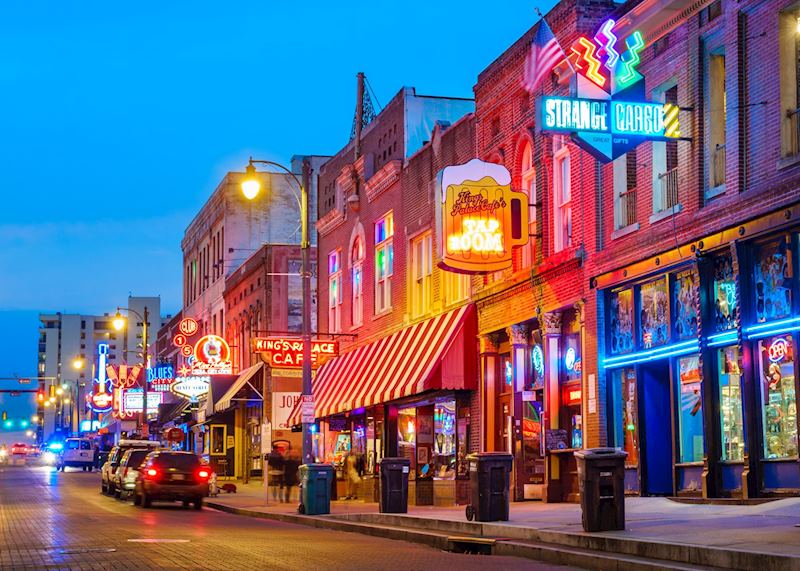
Other music museums in Memphis
I love the museums in Memphis — they’re as interactive and immersive as they are informative. In the Stax Museum of American Soul Music, you can walk through a reconstructed early-1900s Mississippi Delta church to discover where soul truly began and later dance like no one’s watching as you take to the museum’s very own dancefloor. While in the Rock ‘n’ Soul Museum, you can spend hours down memory lane as you listen to classic hits from the vintage juke boxes.
Of course, there are plenty of traditional museum exhibits, too, where you can admire a myriad of star-studded arteiacts, like Isaac Hayes’ gold-trimmed 1972 Cadillac, Tina Turner’s glittering fringed dress, and B.B. King’s ‘Lucille’ guitar.
Though not directly music-related, the National Civil Rights Museum is well worth a visit, too. It’s located at the Lorraine Motel, where Dr Martin Luther King Jr. was assassinated in 1968. You’ll, of course, learn about his life and legacy, but it also provides invaluable context to the music that has put Memphis on the map. It pairs perfectly with the Stax Museum, which delves into the role artists played in the Civil Rights Movement and how this shaped the genres we love and admire today.
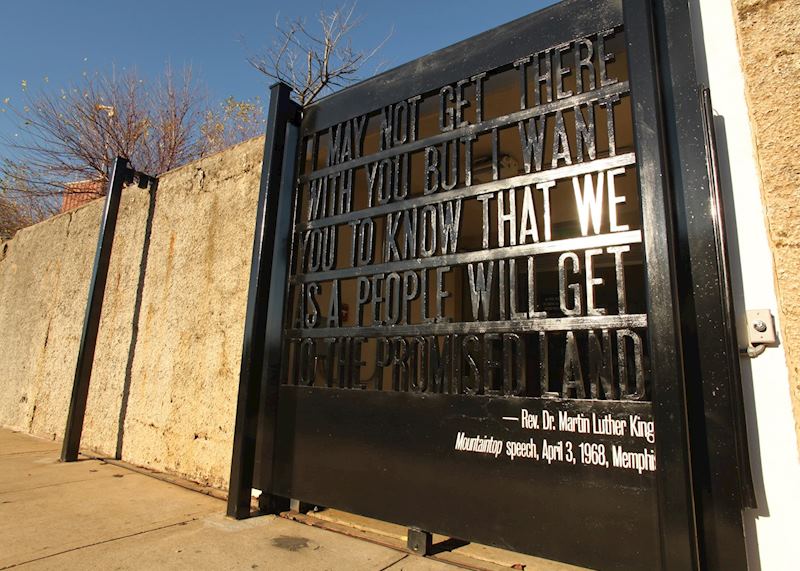
Music experiences in Clarksdale: Delta blues
A small, unassuming town in the heart of Mississippi, Clarksdale doesn’t have the reputation of its surrounding music cities, but it turned out to be the highlight of my trip. It’s considered the birthplace of blues, and live music still pours out of its bars every day of the week. In fact, as soon as I pulled into the town, I could hear music drifting toward me.
What I love most about Clarksdale is its authenticity. There are no big brands here, just small, independent stores, restaurants, and music venues, and everyone knows everyone. By the end of my stay, it seemed like everyone knew me, too — people would call me over for a chat, sharing their traditions and culture in a way that’s hard to find in bigger cities.
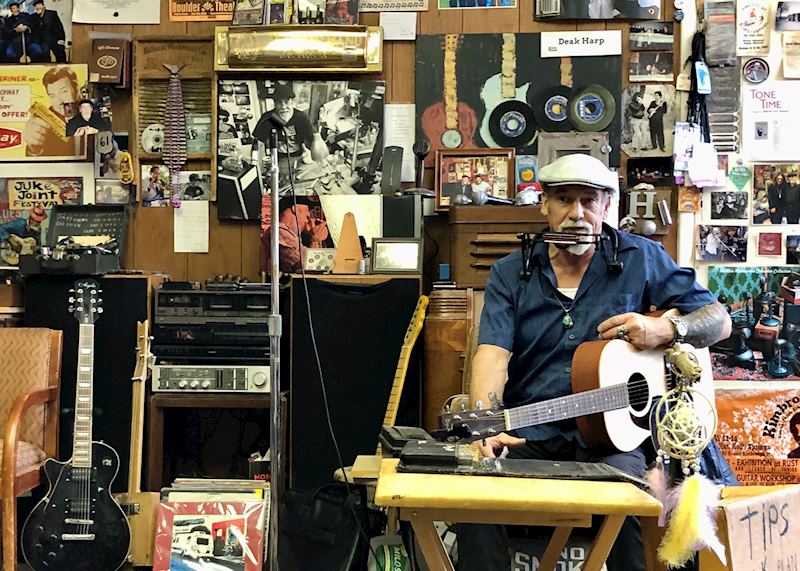
The Clarksdale crossroads monument
Legend has it that prolific blues musician Robert Johnson sold his soul to the devil in exchange for musical mastery on a crossroads near Clarksdale. Though the precise location of the crossroads is disputed, the point where Highway 61 meets Highway 49 has become a pilgrimage point of sorts for blues lovers across the globe.
The meeting point is marked with a huge sign, adorned with three blue guitars — an homage to one of the greatest blues musicians of all time. There’s not much else to see here (it is, after all, just an intersection), but it’s worth simply gazing up at the monument, with the twang of Johnson’s Cross Road Blues ringing out in your headphones.
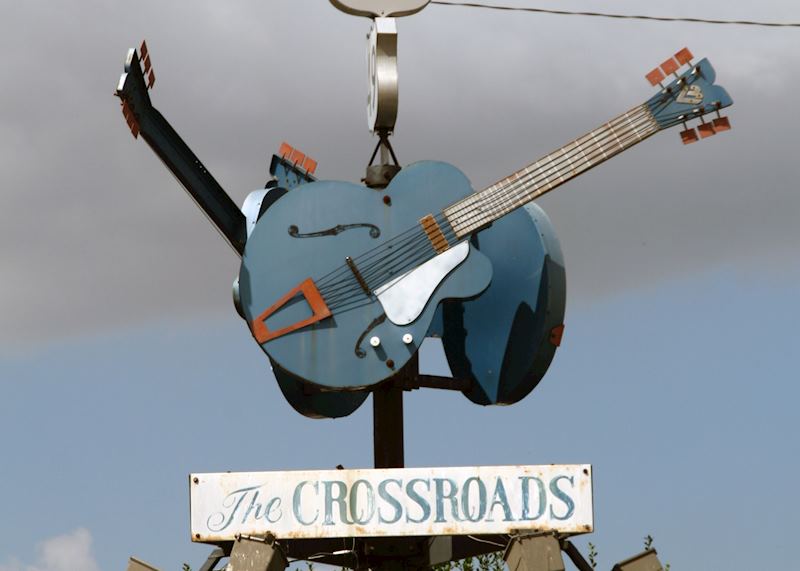
Laid-back juke joints in Clarksdale
Though there are a couple of larger bars in Clarksdale, like the weathered-brick Ground Zero Blues Club, it’s the intimate juke joints that make the town so special. These small, inconspicuous establishments feel more like someone’s home than they do a bar. An eclectic mix of sofas and dining chairs clutter the floor, you pick your drinks from a cooler rather than a bar counter, and bands jam instead of playing polished sets.
As you walk around the town, keep your eyes peeled for make-shift cardboard signs on the street, and you’ll likely stumble upon a couple. I particularly liked Bad Apple Blues Club, run by bluesman Shaun. He took my entrance fee, handed out drinks from the cooler, played a few songs, and told stories in between — a one-man band indeed.

Music experiences in New Orleans: Jazz
Music is just a part of life in New Orleans. You walk to the sound of saxophonists busking on street corners. Live jazz streams from the open doors of bars lining Frenchmen Street. And, in the French Quarter, you might find yourself clapping along to a second line, a traditional brass-band parade that celebrates weddings, funerals, and everything in between.
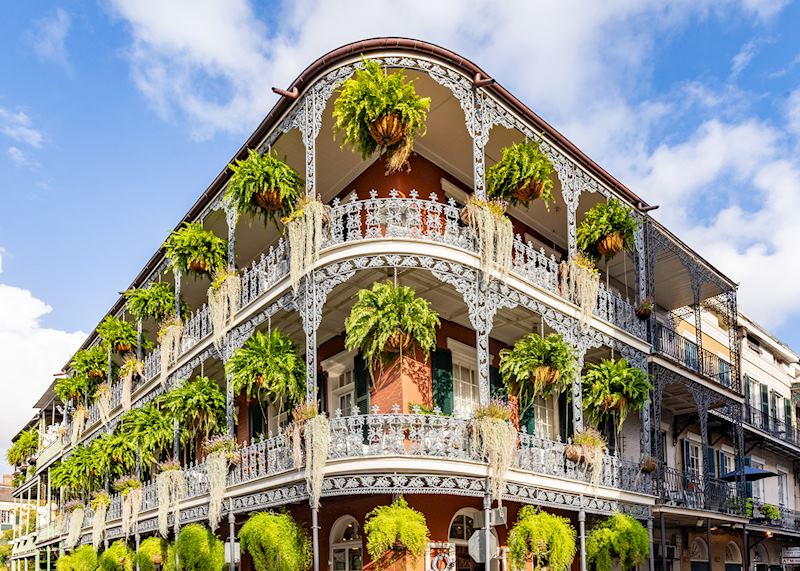
The jazz bars of Frenchmen Street
Though New Orleans’ best-known nightlife spot is Bourbon Street in the heart of the French Quarter, it’s become more of a visitor attraction than a local haunt, so it can become rowdy at night. Sadly, I’d say it has lost its authenticity.
Nowadays, Frenchmen Street is where I’d go. There are lots of traditional jazz bars you can dip in and out of here, and you’ll find every shade of jazz imaginable, from 1920s French jazz to more modern and experimental varieties. I particularly like the very intimate Three Muses bar, which also serves excellent food including tender, slow-cooked pork roast and Cajun-inspired shrimp fettucine.
Snug Harbor is another option. It hosts two live jazz performances every evening to suit both early birds and night owls. And then there’s The Maison, one of the larger venues with different bands playing each night across three stages.
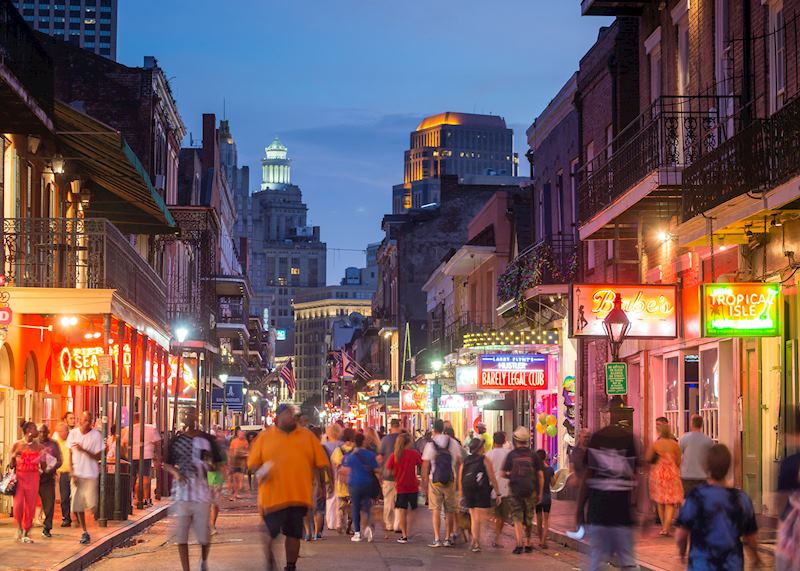
Intimate jazz performances at Preservation Hall
From the outside, Preservation Hall resembles a dilapidated, long-abandoned building. A rusted iron balcony runs around bare brown walls, and its large windows have battered wooden frames. The entrance is barred during the day, the simple sign hanging above it easy to miss.
Every evening, though, the place comes to life with the syncopated rhythms of traditional New Orleans jazz. Performances have reverberated within the building’s walls since it opened in 1961 in an attempt to revive jazz’s popularity. The venue has since grown so popular that it holds several shows each night. It even has a touring band, who perform around the world.
With space for only 100 or so audience members, the acoustic shows have an intimacy that I’ve found hard to beat in other major venues. You sit almost within touching distance of the band, and the sounds they create bounce around the room like a surround-sound speaker.
What I like most about the performances is how they’re at the whim of the audience. Requests from the floor dictate much of the hour-long show, so it’s different every time you go.
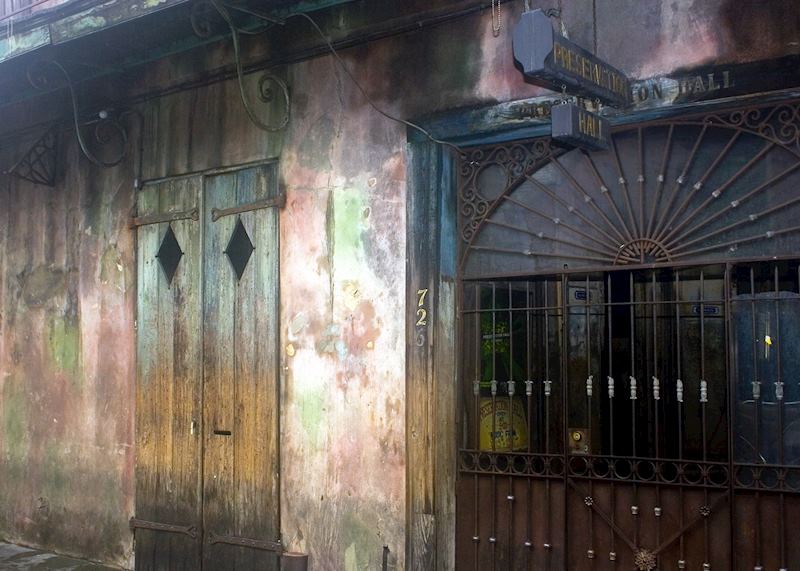
Jazz brunch in New Orleans
You can combine New Orleans’ two great loves — music and food — over a ‘Jazz Brunch’ at the Court of Two Sisters, a Creole restaurant in a 19th-century French Quarter building. As you sit in the leafy courtyard, a jazz trio performs songs, inviting you to sing along while you dine.
It’s a casual, light-hearted way to experience traditional jazz, and it comes with a generous helping of Southern cuisine, too. For breakfast, order any style of eggs, sausages, bacon, hash browns, grits, and grillades. Or, if you’re visiting in the afternoon, try Creole jambalaya, chicken and andouille gumbo, or barbecue pork ribs.
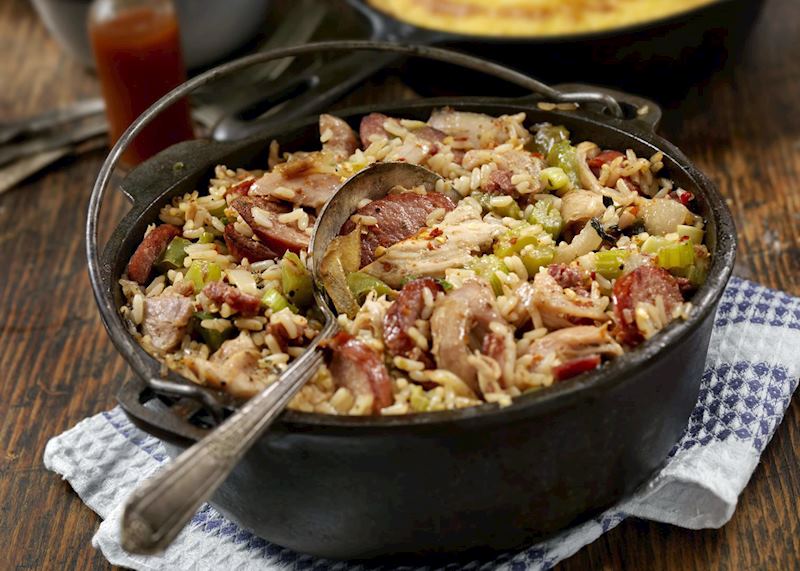
Jazz cruise on the Mississippi River
For a different perspective on jazz and to get out onto the water, I recommend spending one of your evenings cruising along the Mississippi aboard Steamboat Natchez. It resembles the traditional paddlewheel steamers that dominated the river in the 19th century and is one of the only remaining vessels of its kind still operating.
The two-hour cruise is more about the atmosphere than the views, though it did give me an alternative angle on the illuminated skyline. Live music is performed on board by the swing-style Dukes of Dixieland Jazz Band, and you’re told about some of the landmarks you pass and the history of New Orleans’s busy port as you go. You can also visit the engine room to see the workings of a traditional steamboat.
The food on board doesn’t compare with what you can get on land, so I suggest eating beforehand. For a speedy (but delicious) pre-cruise dinner, grab a shrimp po’ boy — you’ll find them around just about every corner. These overstuffed sandwiches are made with soft, chewy French bread and filled with deep-fried seafood on a bed of crisp lettuce slathered in sauce.
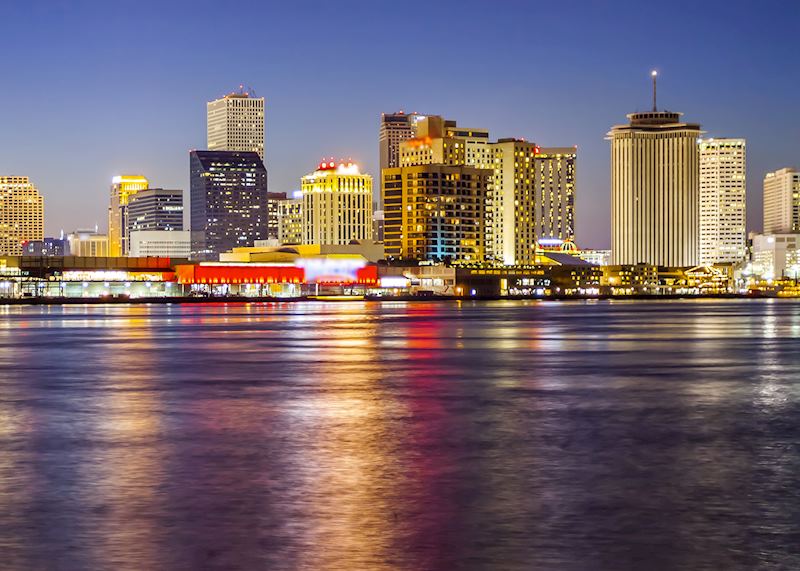
Extend your musical journey to Alabama
Though Alabama often flies under the radar on a classic music tour of the American South, it’s well worth a detour on the drive between Memphis and New Orleans, if you have time. The birthplace of W.C. Handy, Dinah Washington, and Hank Williams, the state is celebrated for its influence on blues and country music across the US.
Just a couple of hours’ drive from Memphis is The Shoals, a collection of towns that boast an array of recording studios with international prestige. Aretha Franklin, Lynyrd Skynyrd, and the Rolling Stones came to record here in the 1960s. You can take behind-the-scenes tours of some studios to uncover their stories, take a peek at their glittering array of awards, and learn about the technology used to create classics like Wild Horses.
Further south, Birmingham is a destination for music and history lovers alike. Here, you can learn about the Civil Rights Movement by day and listen to jazz echoing through the downtown clubs by night. For a deeper dive into Civil Rights history, be sure to spend a couple of days in Montgomery, too. This was where Rosa Parks sparked the year-long Montgomery Bus Boycotts when she refused to give up her seat to a white man. Take a stroll around the Rosa Parks Museum to learn about her pivotal role in the Civil Rights Movement.
Alabama’s capital also plays host to the Hank Williams Museum, where you can delve into the life and music of the singer-songwriter who’s often regarded as country music’s first superstar. Founded by long-time fan Cecil Franklin, the museum has an extensive collection of memorabilia, including the singer’s Steinway piano, 1937 Gibson guitar, and his renowned 1952 baby-blue Cadilliac.
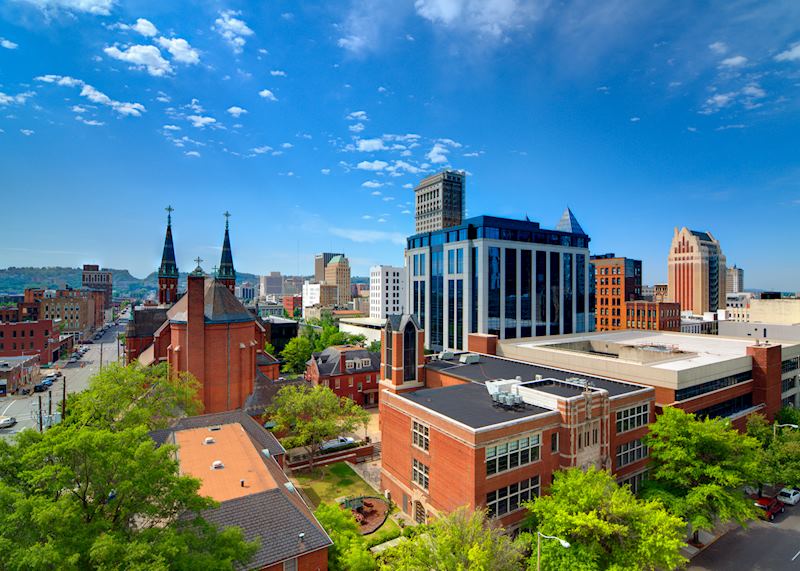
Trip ideas: The South
Start thinking about your experience. These itineraries are simply suggestions for how you could enjoy some of the same experiences as our specialists. They're just for inspiration, because your trip will be created around your particular tastes.
View All Tours in The South
